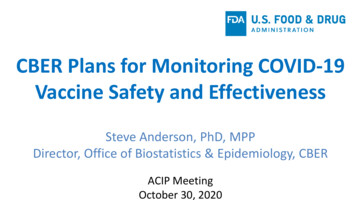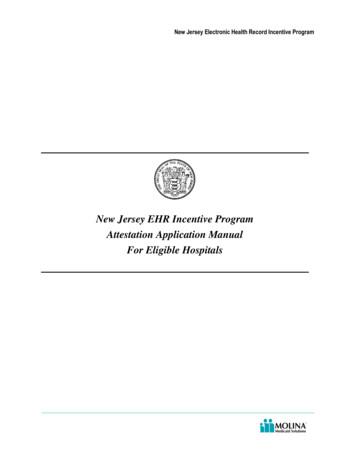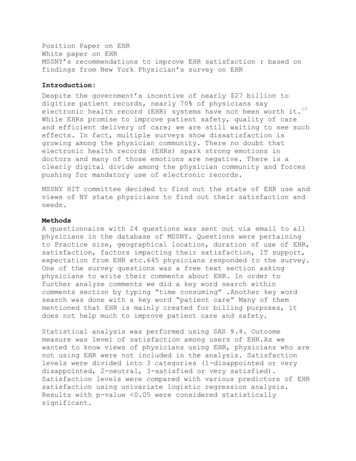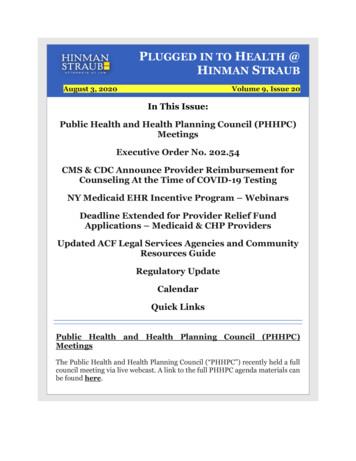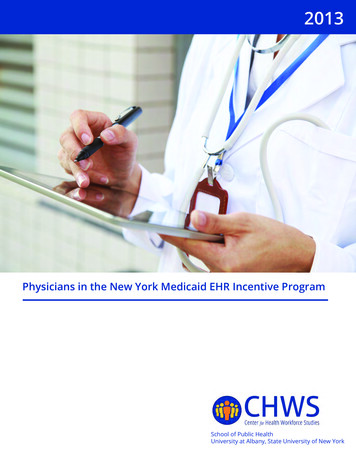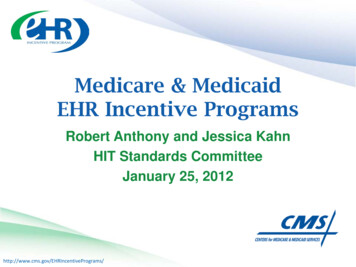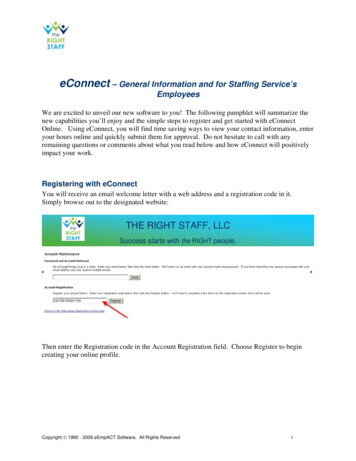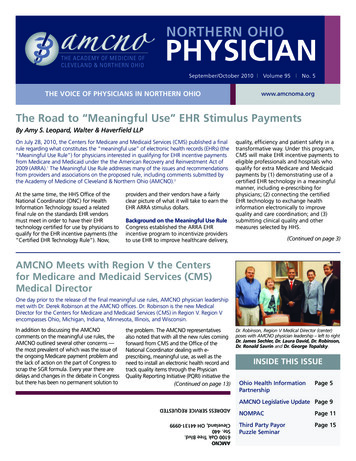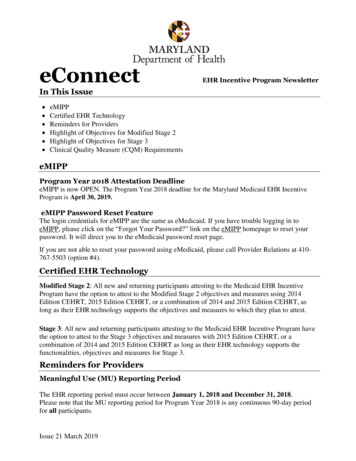
Transcription
eConnectEHR Incentive Program NewsletterIn This Issue eMIPPCertified EHR TechnologyReminders for ProvidersHighlight of Objectives for Modified Stage 2Highlight of Objectives for Stage 3Clinical Quality Measure (CQM) RequirementseMIPPProgram Year 2018 Attestation DeadlineeMIPP is now OPEN. The Program Year 2018 deadline for the Maryland Medicaid EHR IncentiveProgram is April 30, 2019.eMIPP Password Reset FeatureThe login credentials for eMIPP are the same as eMedicaid. If you have trouble logging in toeMIPP, please click on the “Forgot Your Password?” link on the eMIPP homepage to reset yourpassword. It will direct you to the eMedicaid password reset page.If you are not able to reset your password using eMedicaid, please call Provider Relations at 410767-5503 (option #4).Certified EHR TechnologyModified Stage 2: All new and returning participants attesting to the Medicaid EHR IncentiveProgram have the option to attest to the Modified Stage 2 objectives and measures using 2014Edition CEHRT, 2015 Edition CEHRT, or a combination of 2014 and 2015 Edition CEHRT, aslong as their EHR technology supports the objectives and measures to which they plan to attest.Stage 3: All new and returning participants attesting to the Medicaid EHR Incentive Program havethe option to attest to the Stage 3 objectives and measures with 2015 Edition CEHRT, or acombination of 2014 and 2015 Edition CEHRT as long as their EHR technology supports thefunctionalities, objectives and measures for Stage 3.Reminders for ProvidersMeaningful Use (MU) Reporting PeriodThe EHR reporting period must occur between January 1, 2018 and December 31, 2018.Please note that the MU reporting period for Program Year 2018 is any continuous 90-day periodfor all participants.Issue 21 March 2019
CMS RegistrationDuring the Program Year 2018 pre-payment review, Maryland Medicaid will use contactinformation (email, address, phone number, etc.) entered during CMS registration to correspondwith providers. If a provider or organization needs to update any contact information, please visitthe CMS registration portal. Once you have updated your CMS registration, please do not revisitthe CMS registration portal as this will only delay processing.If your contact information did not change from the previous Program Year, there is NO NEED toreturn to the CMS registration portal.Supporting DocumentationMaryland Medicaid must review supporting documentation before approving EHR IncentiveProgram attestations. Before submitting your attestation, please upload the following documents inthe “Upload Documents” tab in eMIPP: The report (“dashboard”) from your EHR showing the numerators and denominators foreach reported MU measure and CQM for your selected reporting period. The Security Risk Assessment (SRA) your organization conducted for Program Year 2018.The following parameters must have been met to satisfy this requirement:o The SRA should have been completed and dated within Program Year 2018. Forexample, for Program Year 2018, the SRA must have been completed betweenJanuary 1, 2018 and December 31, 2018.o The SRA should address threats/vulnerabilities to electronic Protected HealthInformation (e-PHI).o The SRA should assign likelihood ratings, impact ratings and risk levels for eachthreat.o For each threat identified as a medium or high risk, the SRA should include aremediation strategy to minimize those risks.o The SRA should address the encryption requirement for e-PHI.o The SRA should identify administrative, physical, and technical safeguards.o The SRA should be specific to your practice.o The SRA should include an Asset Inventory. For each asset (such as server,computer, etc.) the practice should have identified the type, location, responsibleperson, and whether it contains PHIo For more guidance, please visit HealthIT.gov.Please note, a Yes/No checklist or simply stating that your PHI is stored on a cloudbased system does not satisfy the SRA requirement. Screenshots that show five clinical decision support (CDS)Screenshots that show drug-drug and drug-allergy check functionality settings and exampleof alerts from your EHR system.2
Highlight of Objectives for Modified Stage 2Eligible Professionals (EPs) Patient Electronic Access Objective 8, Measure 2: For an EHR reporting period in 2018,more than 5 percent of unique patients seen by the EP during the EHR reporting period (orhis or her authorized representatives) view, download or transmit to a third party their healthinformation during the EHR reporting period. Secure Electronic Messaging Objective 9: For an EHR reporting period in 2018, more than5 percent of unique patients seen by the EP during the EHR reporting period, a securemessage was sent using the electronic messaging function of CEHRT to the patient (or thepatient-authorized representative), or in response to a secure message sent by the patient (orthe patient-authorized representative) during the EHR reporting period. View the Modified Stage 2 Specification Sheet for EPsEligible Hospitals (EHs)/Critical Access Hospitals (CAHs)Dual Eligible (Medicaid/Medicare) Hospitals: Patient Electronic Access Objective 6, Provide Patient Access: For an EHR reporting periodin 2018, for more than 50 percent of all unique patients who are discharged from theinpatient or emergency department (POS 21 or 23) of a dual-EH or CAH, timely access toview online, download and transmit to a third party their health information is provided. Patient Electronic Access Objective 6, View, Download or Transmit (VDT): At least onepatient (or patient-authorized representative)* who is discharged from the inpatient oremergency department (POS 21 or 23) of an eligible hospital or CAH during the EHRreporting period VDTs to a third party his or her health information during the EHRreporting period. *Reduced from more than 5 percent to at least one View the Modified Stage 2 Specification Sheet for Dual-Eligible HospitalsHighlight of Objectives for Stage 3Objectives and Measures All providers are required to attest to a single set of objectives and measures.o EPs must attest to a set of 8 objectives.o Dual-Eligible Hospitals must attest to a set of 6 objectives. View the Stage 3 Specification Sheets for EPs and Dual-Eligible Hospitals.Eligible Hospitals (EHs)/Critical Access Hospitals (CAHs) Patient Electronic Access Objective 3, Provide Patient Access: For more than 50 percent*of all unique patients discharged from the eligible hospital or CAH inpatient or emergencydepartment (POS 21 or 23): (1) the patient (or the patient-authorized representative) isprovided timely access to VDT his or her health information; and (2) the provider ensures3
the patient's health information is available for the patient (or patient authorizedrepresentative) to access using any application of their choice that is configured to meet thetechnical specifications of the application programming interfaces (APIs) in the provider'sCEHRT.*Reduced from more than 80 percent to more than 50 percent Patient Electronic Access Objective 3, Patient-Specific Education: The eligible hospital orCAH must use clinically relevant information from CEHRT to identify patient-specificeducational resources and provide electronic access to those materials to more than 10percent* of unique patients discharged from the eligible hospital or CAH inpatient oremergency department (POS 21 or 23) during the EHR reporting period.*Reduced from more than 35 percent to more than 10 percent Coordination of Care Objective 4, VDT: During the EHR reporting period, at least oneunique patient (or their authorized representatives)* discharged from the eligible hospitalor CAH 4 inpatient or emergency department (POS 21 or 23) actively engages with theEHR made accessible by the provider and engages in one of the following: (1) VDT to athird party their health information; or (2) access their health information through the use ofan API that can be used by applications chosen by the patient and configured to the API inthe provider's CEHRT; or (3) a combination of (1) and (2).*Reduced from more than 5 percent to at least one Coordination of Care Objective 4, Secure Messaging: For more than 5 percent* of allunique patients discharged from the eligible hospital or CAH inpatient or emergencydepartment (POS 21 or 23) during the EHR reporting period, a secure message was sentusing the electronic messaging function of CEHRT to the patient (or the patient-authorizedrepresentative), or in response to a secure message sent by the patient (or the patientauthorized representative).*Reduced from more than 25 percent to more than 5 percent Health Information Exchange Objective 5, Send a Summary of Care: For more than 10percent* of transitions of care and referrals, the eligible hospital or CAH that transitions orrefers their patient to another care setting or provider: (1) creates a summary of care recordusing CEHRT; and (2) electronically exchanges the summary of care record.*Reduced from more than 50 percent to more than 10 percent Health Information Exchange Objective 5 ,Request/Accept Summary of Care: For morethan 10 percent* of transitions or referrals received and patient encounters in which theprovider has never before encountered the patient, the eligible hospital or CAH incorporatesinto the patient's EHR an electronic summary of care document.4
*Reduced from more than 40 percent to more than 10 percent Health Information Exchange Objective 5, Clinical Information Reconciliation: For morethan 50 percent* of transitions or referrals received and patient encounters in which theprovider has never before encountered the patient, the eligible hospital or CAH performs aclinical information reconciliation. The provider must implement clinical informationreconciliation for the following three clinical information sets: (1) medication: review of thepatient's medication, including the name, dosage, frequency, and route of each medication;(2) medication allergy: review of the patient's known allergic medications; and (3) currentProblem list: review of the patient's current and active diagnoses.*Reduced from more than 80 percent to more than 50 percent Public Health and Clinical Data Registry Reporting Objective: We reduced the reportingrequirement for eligible hospitals, CAHs, and Dual Eligible hospitals attesting to CMS toany combination of three measures*.*Reduced to any combination of three measures from any combination of four measuresFlexibility within Objectives and Measures Stage 3 includes flexibility within certain objectives to allow providers to choose themeasures most relevant to their patient population or practice. The Stage 3 objectives withflexible measure options include:o Coordination of Care through Patient Engagement – Providers must attest to allthree measures and must meet the thresholds for at least two measures to meet theobjective.o Health Information Exchange – Providers must attest to all three measures andmust meet the thresholds for at least two measures to meet the objective.o Public Health Reporting – EPs must attest to two measures, Medicaid-onlyhospitals must attest to four measures and Dual-Eligible hospitals must attest tothree measures.Program Year 2018 Clinical Quality Measure (CQM) RequirementsEligible Professionals (EPs)CQM Requirements CMS has eliminated the requirement to report on CQMs across three of the six NationalQuality Strategy (NQS) domains. Medicaid EPs will report any 6 CQMs relevant to theirscope of practice, regardless of whether they report by attestation or electronically andregardless of participation year. CMS has aligned the specific CQMs available to EPs participating in the Medicaid EHRIncentive Program with the 53 eCQMs available to clinicians participating in Merit-BasedIncentive Payment System (MIPS) who submit electronic CQMs.5
CQM Reporting Period EPs may submit data for a minimum of 90 days during calendar year (CY) 2018, regardlessof participation year and whether they report CQMs electronically or by attestation. Providers that report CQMs electronically for the Medicaid EHR Incentive Program will beable to align their selected reporting period to their performance period under the MIPS.Eligible Hospitals (EHs) & Critical Access Hospitals (CAHs)CQM Requirements EHs/CAHs reporting electronically are required to report for any 4 CQMs, regardless ofparticipation year. EHs/CAHs reporting CQMs by attestation must report on all 16 available CQMs,regardless of participation year.CQM Reporting Period EHs/CAHs reporting CQMs electronically are required to submit data for one self-selectedcalendar quarter during CY 2018, regardless of participation year. EHs/CAHs reporting CQMs by attestation that have previously demonstrated MeaningfulUse must submit CQM data for the entire CY 2018For an Attestation Checklist.For the eMIPP User Guide.If you have questions or concerns, please contact our Meaningful Use Support team at CRISP atsupport@crisphealth.org or call 877-952-7477.To view more information about the requirements for Program Year 2018, please visit the CMS MeaningfulUse website6
The EHR reporting period must occur between January 1, 2018 and December 31, 2018. Please note that the MU reporting period for Program Year 2018 is any continuous 90-day period for all participants. 2 CMS Registration During the Program Year 2018 pre-payment review, Maryland Medicaid will use contact
